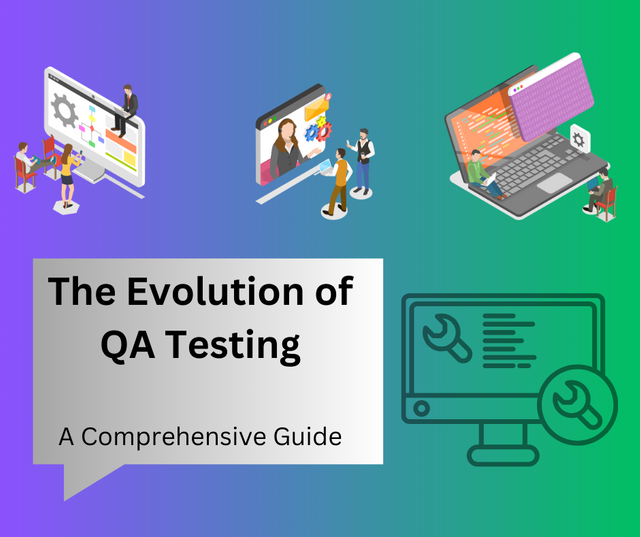The Evolution of QA Testing: A Comprehensive Guide
Over the years, Quality Assurance testing has experienced a substantial evolution, progressing from manual testing procedures to sophisticated automated methodologies. This article will examine the evolution of QA testing, covering its inception, the influence of the digital revolution, the significance of Agile methodology, the ascent of AI and machine learning, and the obstacles and forthcoming trends in the domain of software quality assurance.
Definition of QA Testing
QA testing, or Quality Assurance testing, is a systematic process that ensures software products meet defined standards and specifications. It involves evaluating various aspects of a system to identify defects and improve overall performance. QA testing encompasses test planning, execution, and result analysis to enhance software quality and user satisfaction. By validating functionality, security, and performance, QA testing helps identify and rectify issues before software release. This meticulous process ensures a reliable and seamless user experience, promoting trust in the software's capabilities. In essence, QA testing is the vital practice of systematically verifying and validating software to guarantee its adherence to predefined quality standards. What is QA testing is an inquiry into the methods and processes employed to guarantee the quality and reliability of software products.
Journey of QA Testing: The Evolution
Automation Takes the Stage
The evolution of QA witnessed a significant milestone with the introduction of automated testing. Automated testing not only accelerated the testing process but also enhanced test coverage and efficiency. However, it brought its own set of challenges, such as selecting the right test cases for automation.
Challenges in QA Evolution
As QA evolved, it faced challenges such as keeping pace with rapid development cycles and ensuring compatibility with diverse technologies. Strategies to overcome these challenges involve a combination of robust planning, continuous learning, and adapting to industry best practices.
DevOps and QA Collaboration
DevOps, a cultural and technological movement, emphasizes collaboration between development and operations. QA seamlessly fits into the DevOps pipeline, ensuring that testing becomes an integral part of the continuous integration and continuous delivery (CI/CD) process.
AI and Machine Learning in QA
The incorporation of Artificial Intelligence (AI) and Machine Learning (ML) has brought a new dimension to QA. AI-driven testing can predict potential areas of failure, automate test case generation, and analyze complex data sets, significantly enhancing the effectiveness of QA processes.
Continuous Testing: Ensuring Quality in Real Time
Continuous testing is a crucial practice in today's fast-paced development environment. It involves automated testing throughout the software development life cycle, providing real-time feedback on the quality of the code. Implementing continuous testing requires a well-defined strategy and the right set of tools.
Security Testing: A Critical Component
In an era of increasing cybersecurity threats, security testing has become a non-negotiable aspect of QA. Embedding security testing into the development process helps identify vulnerabilities early on, preventing potential breaches and safeguarding sensitive data.
The Human Element in QA
Despite the rise of automation, the human element remains indispensable in QA. Human testers bring critical thinking, creativity, and domain expertise to the testing process. Striking the right balance between automation and manual testing is essential for comprehensive QA.
Evolving Metrics in QA Assessment
Traditional QA metrics have evolved to align with the dynamic nature of modern development practices. Metrics now focus on speed, efficiency, and customer satisfaction. Understanding and applying the right metrics is crucial for assessing the effectiveness of QA processes.
Globalization and QA Challenges
Globalized development teams present unique challenges to QA. Differences in time zones, cultural nuances, and varied development practices can impact the efficiency of testing processes. Implementing collaborative tools and communication strategies is vital for overcoming these challenges.
Future Trends in QA
Looking ahead, the future of QA testing holds exciting possibilities. From increased reliance on AI and ML to the integration of cutting-edge technologies like blockchain, QA is poised for continuous evolution. Staying informed about emerging trends is crucial for QA professionals to adapt and thrive in the ever-changing landscape.
How to become QA Tester?
To become a QA Tester, enroll in a comprehensive QA testing course online to acquire a strong understanding of software development processes and testing methodologies. Familiarize yourself with testing tools and automation frameworks. Learn programming languages like Java or Python, and gain expertise in bug tracking systems. Pursue relevant certifications such as ISTQB to enhance your credibility. Develop effective communication skills to collaborate with developers and stakeholders. Gain hands-on experience through internships or freelance projects, showcasing your ability to identify and report bugs. Stay updated on industry trends and continuously expand your knowledge of different testing types. A combination of technical proficiency, attention to detail, and communication skills will position you for a successful career as a QA Tester.
Conclusion
The journey of QA testing has been a fascinating exploration of adaptability and innovation. From its humble beginnings to the current landscape of AI-driven testing and continuous integration, QA has played a pivotal role in ensuring the delivery of high-quality software. As the industry continues to evolve, staying informed and embracing change will be key to navigating the future of QA testing.
